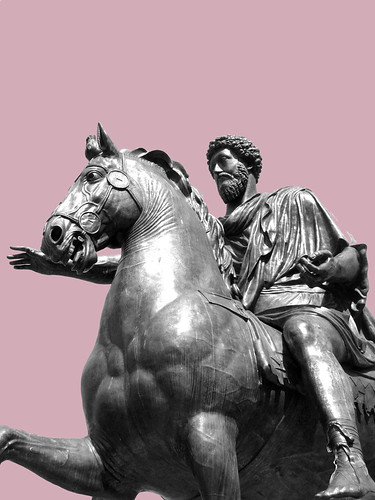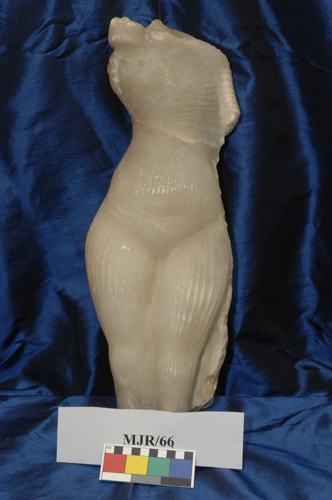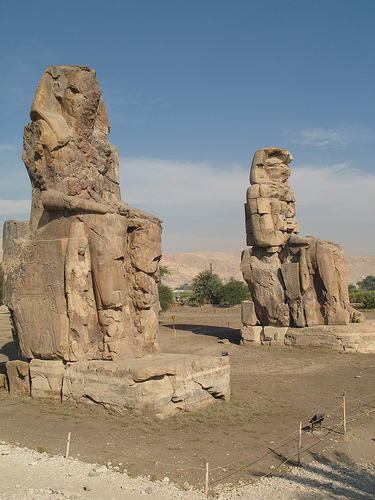News of this exhibit has been leaking out in bits and pieces for weeks. But today the official announcement of it was made and full details have been released. The exhibit will be hitting the Royal Ontario Museum in Toronto Canada starting in late June. The precise exhibition start/end dates are being arranged. As reported earlier the exhibit will be stopping at the Glenbow Museum in Calgary and the Royal BC Museum in Victoria BC. A stop in Montreal was announced several months back. Also, as hk previously reported, this will be the biggest Terracotta Warriors exhibition ever to hit…
-
-
Very few large equestrian statues from antiquity have survived until modern times. Two that have reached us are the bronze statue of the Roman emperor Marcus Aurelius, on display in the Capitoline Museums in Rome, and the Greek marble statue in fragments known as the Rampin Rider. Found by Georges Rampin in the late 19th century in Athens, it is a masterpiece of Archaic art and pre-dates the much more intact bronze of Marcus Aurelius by about 700 years. Each statue tells us a huge amount about the time and place they come from the Rampin Rider from Athens in…
-
Roman Britain A New History by Guy de la Bédoyère In this lively, authoritative account of a crucial period in Britains history, Guy de la Bédoyère puts the Roman conquest and occupation within the larger context of Romano-British society and how it functioned.With nearly 300 illustrations and dramatic aerial views of Roman sites, and brimming with the very latest research and discoveries, Roman Britain will delight and inform all those with an interest in this seminal epoch of British history. Thames & Hudson (22 Feb 2010) 288 pages
-
The rich and famous people of ancient Egypt lived a decadent lifestyle with fine wine, sex, high fashion, and plenty of partying. How do they compare with their equivalents today – the modern western celebrity set? The main differences might be regarding who were the richest people then, and who are the richest people now. In ancient Egypt the pharaoh was at the top of the pyramid and his family, noble people who owned land, and the priests came after. Scribes, architects and doctors were well off, and skilled craftsmen also had many privileges. Peasants and unskilled workers were low…
-
Actor and Director Mel Gibson is working on a Viking-themed film that is going to star Leonardo DiCaprio, who will have to brush up on his Old Norse. The script is in the hands of Oscar-winning screenwriter William Monahan, and will chronicle the Viking raids on England and Scotland in the ninth century. When asked about the Viking project at a recent press event, Mel Gibson told Collider.com: I think its going to be English – the English that would have been spoken back then – and Old Norse. Whatever the 9th century had to offer. Im going to give…
-
The official announcement is coming a week today (January 27) but news continues totrickle out about the exhibition of the Terracotta Warriors of the First Emperor, Qin Shi Huang, set to hit Toronto in June. Officials have been tight-lipped about this exhibit so what we’ve been hearing has been in drips and drabs. Last week we learned that the Toronto show is going to be the largest Terracotta Warrior’s showever to hit North America. We also learned that it will likely be one of four Canadian stops -with Toronto coming up first. There will be a Canadian tour, Montreal has…
-
This Saturday the Victoria and Albert Museum in London will open a show that is all about a fake, in partnership with Scotland Yard. The exhibit, Metropolitan Police Service’s Investigation of Fakes and Forgeries, will explore the work of counterfeit mastermind Shaun Greenhalgh, and reveal some of the techniques used by the police to spot fakes. Over a 17 year period Greenhalgh created fake art pieces that fooled museum experts and sold for sums as high as six figures. Sentenced in 2007 he is currently serving a four year prison sentence. His parents Olive and George Greenhalgh, who assisted in…
-
King Tut Virtual Photo Contest attracted almost 200 wonderful photos of Kig Tut Virtual. Taking good, quality, high-resolution photographs anywhere in the metaverse takes quite a bit of time, effort and creative genius, so now we have chosen the winners which receive 100$ for the most fabulous high resolution shots taken in King Tut Virtual. Loki Popinjay, a well known metaverse photographer had so many breath taking photos that we had seriously hard time to figure out which one to be the winner. The artefacts in King Tut Virtual are very real life like and still Loki has captured the…
-
Discovered inside the Tomb of King Tutankhamun, inside black resin-covered wooden shrines which were accessible via double doors, were 34 ritual figures. Of significant importance during the ritual ceremony, these statuettes are believed to assist the King Tut’s passage to the afterlife. Upon discovering the shrines in KV62, the great explorer Howard Carter found only one of the boxes had been raided by tomb robbers, with the rest laying undisturbed since antiquity. The ritual figures are now housed inside Cairo’s Egyptian Museum and have been captured on film by Sandro Vannini, who has photographed Egypt’s greatest treasures including the famous…
-
Attribution: Masterplaan Thebes Egypt Key Dates The temple was built in the reign of Amenhotep III, which lasted from around 1391 to 1353 BC. Since 1998, it has been on the World Monument Fund’s list of the planet’s 100 most endangered monuments. Excavation at the site began in 2004, and is expected to be ongoing until around 2027. Key People The temple was built as a funerary monument for Amenhotep III, the most powerful, rich and influential pharaoh in Egyptian history. Research at the site is being headed by German-Armenian Egyptologist Dr Hourig Sourouzian. Dr Hourig Sourouzian Amenhotep III The…







